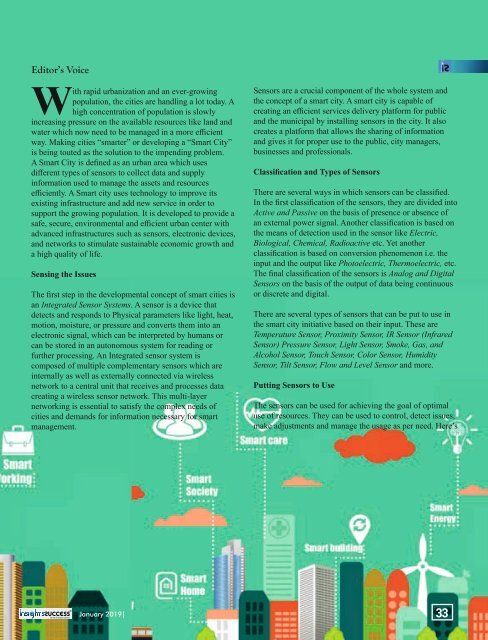The 10 High Tech Sensor Solution Providers
"Recognizing the companies which are revolutionizing the world of sensors and keeping innovation on their radar by staying up-to-speed with the developments, we have come up with this special edition of “The 10 High Tech Sensor Solution Providers.” This issue has featured a handful of ‘pros’ offering a diversified and engaging blend of creativity and distinctiveness. This edition of ours will help you to walk through a list of companies embracing multidisciplinary approach and covering a range of relevant issues in its sector."
"Recognizing the companies which are revolutionizing the world of sensors and keeping innovation on their radar by staying up-to-speed with the
developments, we have come up with this special edition of “The 10 High Tech Sensor Solution Providers.” This issue has featured a handful of ‘pros’ offering a diversified and engaging blend of creativity and distinctiveness. This edition of ours will help you to walk through a list of companies embracing multidisciplinary approach and covering a range of relevant
issues in its sector."
Create successful ePaper yourself
Turn your PDF publications into a flip-book with our unique Google optimized e-Paper software.
Editor’s Voice<br />
With rapid urbanization and an ever-growing<br />
population, the cities are handling a lot today. A<br />
high concentration of population is slowly<br />
increasing pressure on the available resources like land and<br />
water which now need to be managed in a more efficient<br />
way. Making cities “smarter” or developing a “Smart City”<br />
is being touted as the solution to the impending problem.<br />
A Smart City is defined as an urban area which uses<br />
different types of sensors to collect data and supply<br />
information used to manage the assets and resources<br />
efficiently. A Smart city uses technology to improve its<br />
existing infrastructure and add new service in order to<br />
support the growing population. It is developed to provide a<br />
safe, secure, environmental and efficient urban center with<br />
advanced infrastructures such as sensors, electronic devices,<br />
and networks to stimulate sustainable economic growth and<br />
a high quality of life.<br />
Sensing the Issues<br />
<strong>The</strong> first step in the developmental concept of smart cities is<br />
an Integrated <strong>Sensor</strong> Systems. A sensor is a device that<br />
detects and responds to Physical parameters like light, heat,<br />
motion, moisture, or pressure and converts them into an<br />
electronic signal, which can be interpreted by humans or<br />
can be stored in an autonomous system for reading or<br />
further processing. An Integrated sensor system is<br />
composed of multiple complementary sensors which are<br />
internally as well as externally connected via wireless<br />
network to a central unit that receives and processes data<br />
creating a wireless sensor network. This multi-layer<br />
networking is essential to satisfy the complex needs of<br />
cities and demands for information necessary for smart<br />
management.<br />
<strong>Sensor</strong>s are a crucial component of the whole system and<br />
the concept of a smart city. A smart city is capable of<br />
creating an efficient services delivery platform for public<br />
and the municipal by installing sensors in the city. It also<br />
creates a platform that allows the sharing of information<br />
and gives it for proper use to the public, city managers,<br />
businesses and professionals.<br />
Classification and Types of <strong>Sensor</strong>s<br />
<strong>The</strong>re are several ways in which sensors can be classified.<br />
In the first classification of the sensors, they are divided into<br />
Active and Passive on the basis of presence or absence of<br />
an external power signal. Another classification is based on<br />
the means of detection used in the sensor like Electric,<br />
Biological, Chemical, Radioactive etc. Yet another<br />
classification is based on conversion phenomenon i.e. the<br />
input and the output like Photoelectric, <strong>The</strong>rmoelectric, etc.<br />
<strong>The</strong> final classification of the sensors is Analog and Digital<br />
<strong>Sensor</strong>s on the basis of the output of data being continuous<br />
or discrete and digital.<br />
<strong>The</strong>re are several types of sensors that can be put to use in<br />
the smart city initiative based on their input. <strong>The</strong>se are<br />
Temperature <strong>Sensor</strong>, Proximity <strong>Sensor</strong>, IR <strong>Sensor</strong> (Infrared<br />
<strong>Sensor</strong>) Pressure <strong>Sensor</strong>, Light <strong>Sensor</strong>, Smoke, Gas, and<br />
Alcohol <strong>Sensor</strong>, Touch <strong>Sensor</strong>, Color <strong>Sensor</strong>, Humidity<br />
<strong>Sensor</strong>, Tilt <strong>Sensor</strong>, Flow and Level <strong>Sensor</strong> and more.<br />
Putting <strong>Sensor</strong>s to Use<br />
<strong>The</strong> sensors can be used for achieving the goal of optimal<br />
use of resources. <strong>The</strong>y can be used to control, detect issues,<br />
make adjustments and manage the usage as per need. Here’s<br />
January 2019| 33


















